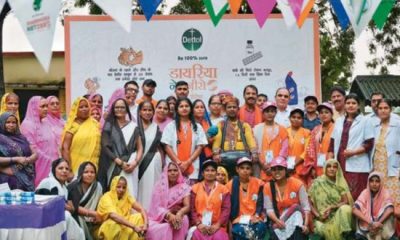Highlights
- Jammu and Kashmir has divided the COVID hospitals into three categories
- Tertiary health care institutions are referred to as category-1 hospitals
- Category-1 hospitals are reserved for critically-ill COVID-19 patients
New Delhi: In an effort to ensure all critically-ill patients of COVID-19 are not bereft of the required treatment, the Jammu and Kashmir government has issued instructions regarding referral of patients to tertiary health care institutions. An order issued by the Department of Disaster Management, Relief Rehabilitation and Reconstruction on Tuesday (July 28) states that a sharp rise in the number of fresh COVID-19 cases is leading to a rise in bed occupancy of COVID hospitals across the Union Territory. As a result of this, critically-ill patients or people who require specialised care are unable to get admission in tertiary health care institutions like SKIMS (Sher – i – Kashmir Institute of Medical Sciences, SMHS (Shri Maharaja Hari Singh) Hospital, Chest Diseases Hospital and others.
Also Read: Coronavirus Explainer: Origins Of COVID-19 Is Still A Critical Missing Piece Of The Pandemic Puzzle
Further elaborating on the existing problem, the order states,
It has also been a practice that COVID positive patients are coming directly to these category 1 or tertiary hospitals and are admitted without their having a need for treatment in such hospitals; thus, causing lot of difficulty and inconvenience to the other more needy patients.
To resolve the issue, the executive committee has issued detailed instructions that are to be implemented across all districts of Jammu and Kashmir, with immediate effect. The new guidelines clearly state of that all COVID positive patients with mild/moderate symptoms shall first be admitted in category-2/3 hospitals, at sub-district/district level or any other hospital which is not a category-1 referral hospital.
The patients shall be admitted and treated in category-1 referral hospitals only if they are duly referred by a concerned district level hospital or a non-category-1 referral hospital. This will be ensured by all the chief medical officers and supervised by the deputy commissioners concerned, reads the order.
Explaining the difference between category 1 and category 2 or 3 hospitals and the reason behind the new guidelines, Dr Neeraj Mumalai from CD Hospital in Jammu said,
In simple terms, category 2 or 3 involves small hospitals whereas category 1 includes large hospitals. Category 2 or 3 hospitals are hospitals at sub-district or district level. They are the first line of care. For instance, someone has only mild symptoms of COVID-19 say fever and cough. Then this person can be treated at a smaller or a local (district level) hospital. If in case thecondition deteriorates, the doctors there can then refer the patient to a category 1 level or tertiary hospital for facilities like ICU, ventilators, pulmonologists, physicians, among others. This will ensure that people who need specialised care are not deprived of it owing to a shortage of beds.
The guidelines also list out the hospitals that have been designated as tertiary care-1 institutions and referred to as category-1 referral hospitals. It includes – SKIMS Soura, SMHS Hospital in Srinagar, Chest Diseases Hospital in Srinagar, and SKIMS Medical College and Hospital Bemina, Government Medical College in Jammu, CD Hospital, ASCOMS (Batra).
The government has ordered Divisional commissioner and the Director of Health Services to put in place a mechanism to monitor the compliance of the instructions at all the levels.
JK Govt issues instructions regarding referral of patients to tertiary health care Institutions; SKIMS Soura, SMHS Sgr, Chest Disease Hospital Sgr, SKIMS Bemina, Sgr in Kmr div & GMC Jmu, CD Hospital Jmu, ASCOMS Batra in Jmu div designated as tertiary care 1 Institutions pic.twitter.com/YwWoBd1flE
— DIPR-J&K (@diprjk) July 28, 2020
Impact Of Coronavirus In Jammu And Kashmir
According to a news agency PTI, on March 9, Jammu and Kashmir reported the first case of COVID-19 after a 63-year-old woman who had a travel history to Iran tested positive. Jammu and Kashmir started to see a sharp rise in COVID-19 cases in late May with over 100 fresh cases being reported almost every day. As on July 27 (5 PM), the valley has recorded over 18,000 cases (18,390) of COVID-19 of which more than 10,000 patients have recovered.
On March 26, the first death due to COVID-19 was reported in Kashmir. The victim was a 65-year-old religious preacher from the Hyderpora neighbourhood of Srinagar, who tested positive three days ago. He had travelled around the country, visiting mosques in Delhi and Uttar Pradesh’s Deoband before returning home on March 16. So far, the union territory has reported 321 fatalities due to COVID-19.
Lately, there has been a spike in COVID-19 cases. On July 18, for the first time, over 600 fresh COVID-19 cases were reported in a single day. In the union territory, the maximum number of cases has been reported from Kashmir division.
In the light of a spike in COVID-19 cases, on July 22, the Jammu and Kashmir administration imposed a six-day complete lockdown in all red districts except for Bandipora district of Kashmir division.
In Kashmir, Srinagar district has the highest case load. 22.4 per cent of the total cases in the Union Territory are from Srinagar.
Also Read: Srinagar Based NGO Serves Daily Essentials To People During Coronavirus Pandemic
The Srinagar district administration is struggling to handle the cases. On July 18, on social media, Srinagar administration shared a clip which clearly stated that the hospitals are running out of space. “Hospitals are running short of beds. A huge number of cases are being detected each day. We are not finding enough place in our hospitals to accommodate all of them,” Dr Naveed Nazir Shah, Head of Department, Chest Disease Hospital and Medical College, Srinagar, says in the clip.
The COVID-19 situation in Kashmir has got to a point where hospitals are running out of space. Here's Dr @naveednazirshah putting it into perspective — throwing light on what has gone wrong and what needs to be done.
| DDMA Srinagar presentation@listenshahid @drsamiarashid pic.twitter.com/pmoVAriSwV— Srinagar district administration (@srinagaradmin) July 18, 2020
For backup, Srinagar district administration has created institutional facility with a capacity of 3,000 beds and plans to add 2,000 more beds.
Made good use of lockdown time for these fully equipped facilities. Please rest assured on this front, reads a tweet from Shahid Choudhary, District Magistrate and Development Commissioner, Srinagar.
While our institutional efforts are on, uninterrupted since March to contain Covid spread, for backup we’ve created 3,000 bed capacity, adding 2,000 more soon in #Srinagar.
Made good use of lockdown time for these fully equipped facilities. Please rest assured on this front pic.twitter.com/c3fzd4DCM6— Shahid Choudhary (@listenshahid) July 24, 2020
NDTV – Dettol Banega Swasth India campaign is an extension of the five-year-old Banega Swachh India initiative helmed by Campaign Ambassador Amitabh Bachchan. It aims to spread awareness about critical health issues facing the country. In wake of the current COVID-19 pandemic, the need for WASH (Water, Sanitation and Hygiene) is reaffirmed as handwashing is one of the ways to prevent Coronavirus infection and other diseases. The campaign highlights the importance of nutrition and healthcare for women and children to prevent maternal and child mortality, fight malnutrition, stunting, wasting, anaemia and disease prevention through vaccines. Importance of programmes like Public Distribution System (PDS), Mid-day Meal Scheme, POSHAN Abhiyan and the role of Aganwadis and ASHA workers are also covered. Only a Swachh or clean India where toilets are used and open defecation free (ODF) status achieved as part of the Swachh Bharat Abhiyan launched by Prime Minister Narendra Modi in 2014, can eradicate diseases like diahorrea and become a Swasth or healthy India. The campaign will continue to cover issues like air pollution, waste management, plastic ban, manual scavenging and sanitation workers and menstrual hygiene.
[corona_data_new]





























